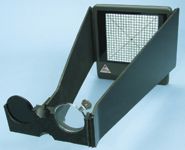Article
Modified version of Amsler grid improves scotoma detection
Montr?al?A modified version of the Amsler grid, with a backlit screen and other changes, improves detection of scotomas and is easier for patients and clinicians to use, according to designer Elie Khouri, MD, a Montr?al ophthalmologist.

The new instrument, called Khouri's scotomascope, features double lines on the squares of the grid and two additional oblique lines to help reveal hidden scotomas. Twelve-inch lateral wings attach the grid to a double lens-holding screen with a 3.25-D lens in one holder and an occluder in the other. The examiner holds the device against his or her chest while facing the patient. The patient's eyes fixate on the grid and look at the central dot.
Dr. Khouri redesigned the traditional Amsler grid, because he perceived limitations of the test. One limitation is that the clinician can't see the patient's eyes while the test is being performed and therefore can't discern whether the patient is following the instructions. Thus, a patient's claim that all the squares are visible and normal may be accepted despite evidence, from a fundus examination, of macular disease. In addition, clinicians may not explain in sufficient detail how the test is to be performed. This can lead to patient errors and false negatives.
"You're confident that the patient is doing the test properly. You're confident that if patients have something, they will see it; and if they tell you it's normal, nine out of 10 times it's normal," Dr. Khouri said.
Dr. Khouri had two inspirations when adding the backlit screen to the traditional grid. One was seeing floaters in his eyes when in bright sunlight, and the other was being able to see them when looking at radiographs on the negatoscope.
Detection of scotomas
"Compared with the old Amsler grid, you can detect many more scotomas," he added. "I have had patients tell me they see their subtle scotoma highlighted on the backlit screen whereas it was not seen on an ordinary Amsler grid. They can tell you whether the metamorphopsia is vertical or horizontal and how many squares are involved. They can tell you the color of the scotoma, and a pseudophakic patient will tell you that the scotoma has a different color from that in the phakic eye. They can tell you whether their scotoma is absolute or relative, and they will see their vitreous floaters."
The backlighting improves visibility and makes it much easier for patients to discern if there is a defect in their vision, said Tom Cockley, president of Gulden Ophthalmics, which manufactures the scotomascope.
"The fact that the distance is fixed eliminates variables such as whether the patient is standing too close or too far away, and it picks up things that could possibly be missed by the normal screen," he said.
Patients find the test easy to use because they can perform it while wearing their own distance-corrected glasses. The image of the grid is at the focal point of the lens so the patient sees the grid without accommodation.
"The lens will put the focus of the Amsler grid exactly in the focus of the lens. The patients are looking at infinity; they have no accommodation whatsoever. When the patients look through that lens while wearing ordinary glasses, they will see exactly what they see during the day," Dr. Khouri said.
The built-in occlusion device is another important enhancement.
Newsletter
Don’t miss out—get Ophthalmology Times updates on the latest clinical advancements and expert interviews, straight to your inbox.




